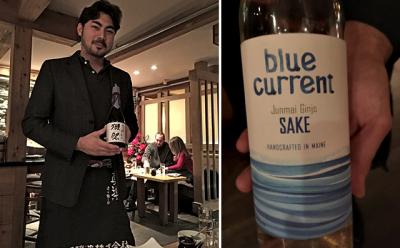Sen’s Sake Social Sundays

A lot of restaurants will try a lot of things to bring in business during the slower months. There are happy hours with meatball sliders, specialty cocktails, free pizza, cheap beer, fondue by the front door, and more. When I heard about Sen’s Sake Social Sundays my interest was piqued. And not just because I can walk home from there. Ryunosuke Jesse Matsuoka is the general manager and a partner at the Sag Harbor restaurant. He is also one of the very few kikizakeshi, or sake sommeliers, in New York, quite possibly the only one on Long Island. Who knew sake was so varied, so complicated, so complex?
From 5:30 to 7, for $28, you can sample many fine examples of sake, with a tutorial from Mr. Matsuoka and tasty treats to go along with the sakes. Sake is pronounced sak-eh, not sak-ee; let’s get that straight right away. Every time I pronounced it incorrectly, Mr. Matsuoka admitted (politely) that it sounded like fingernails on a chalkboard. Gomen ne, Jesse, I’m sorry!
We began with Blue Current, a sake brewed in Kittery, Me., of all places. It was slightly sweet and smoky. Along with this lightly chilled sake we enjoyed some edamame and little skewers of kushiyaki, pork tenderloin strips marinated in soy and mirin.
Mr. Matsuoka pointed out that “rice is the heart of sake; it is the heart of Japan.” Sake rice is different from sushi rice in that it is more delicate and grows taller, making it vulnerable to high winds. The starch in some strains of rice is contained in the very center, which means it has to be milled, or refined, up to 50 to 70 percent, sometimes even more, to reach the starch. In other words, the finer sakes have been made from an ingredient of which 70 percent has been discarded. Now I’m starting to understand why some can be quite expensive. The quality of the water used is also of utmost importance.
Next we tried Hyakujuro 110 with wagyu beef and daikon pickle tartare on crunchy sushi rice with scallions. This sake was delicate and a bit fruity. The wagyu tartare was one of the best things I have ever tasted, and Sen only rolls it out during holiday seasons.
Once upon a time there were over 6,000 sake breweries in Japan, now there are approximately 1,200. Apparently, the younger generation has very little interest in making and/or drinking sake. They are currently enamored with French wines and whiskey.
I asked Mr. Matsuoka if he prefers chilled sake over hot. He said he enjoys it in any form and pointed out that sake is one of the few alcoholic beverages that have this flexibility of being served from yukibie, snow chilled, to tobikirikan, extremely hot.
“My job is to get people to relate to it, even if they already enjoy it. I want to break the mold, have people realize they can drink sake every day. If you break it down, the profiles are succinic acid, also found in shellfish, and lactic acid, which gives some sakes that creamy flavor.” Which makes sake very compatible with cheese. He suggested trying Midnight Moon, an aged goat cheese in the style of Gouda, with brown butter and caramel undertones. While the more refined sakes do cost a pretty penny, he insists that price doesn’t matter; it’s really just a matter of preference.
Why do some of the sakes have such poetic, romantic names like Raindrops From the Maple Leaf, Plum Tree in the Snow of Kaga Area, Flower in Winter, Glory of the Sun, Nightingale in the Garden, and Hawk’s Bravery? This is strictly for the American market because, well, who really knows what Banshu Ikkan Kaede no Shizuku means, much less remembers to ask for it at the liquor store?
Next we had seared sea scallops with miso sauce on fried wonton chips served with Born Gold, a moderately pricey bottle that can rival sakes priced in the hundreds. It was slightly sweet and light golden. A sampling of mushroom and tofu soup and some vegetable sushi followed. Because our gang of tasters was relatively small, Mr. Matsuoka decided to share one of his favorite sakes with us, Dassai 23, which sells for $160 on Sen’s menu. Lucky us!
At this point, another group came in to join the class. Jesse switched gears and began from scratch with the new group, which left us to ponder and savor the intricacies, customs, etiquette, and beauty of Japanese culture, and especially sake.
Dr. Andrew Weill says that the purest sakes, such as Daiginjo, are so refined they do not cause hangovers. I’d prefer to not put this theory to the test, but I would agree that this ancient beverage is fascinating, fun, and utterly delicious, especially when enjoyed with friends and under the guidance of the only kikizakeshi on Long Island.
The tastings at Sen will continue through December and possibly beyond. Each event is different; even the weather plays a part in determining what Jesse will serve and talk about.
Domo arigato, Jesse!
